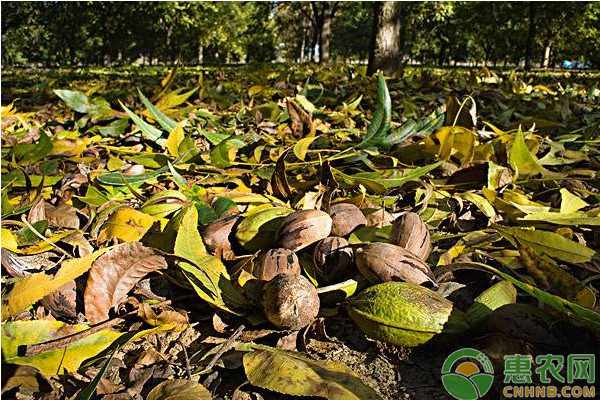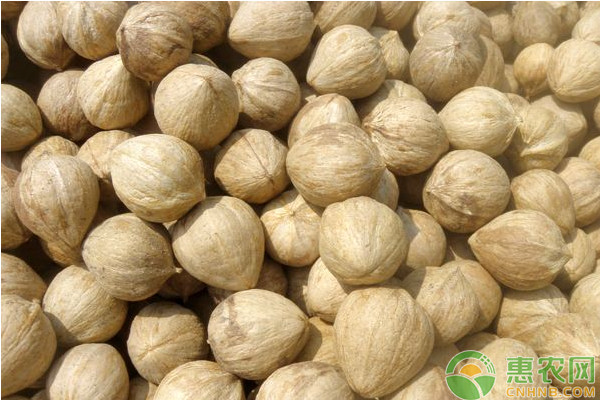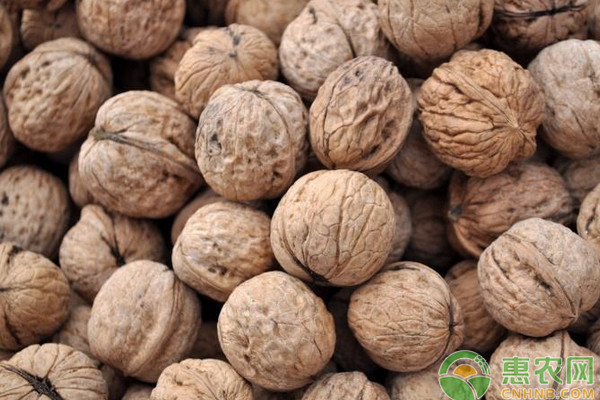How is the American pecan planted? Pecan is one of the famous Dried Fruit trees, which can be used as a garden landscape. The following is a summary of a US pecan management cultivation technology.

1 Cultivation management of young trees
1.1 Post-plant management
Immediately after planting, the water should be poured once, and after 2 weeks, the water should be poured again. Each tree retains 3-4 new shoots and the excess shoots need to be removed. In the same year, the new branch of newly planted walnut trees was generally controlled at 50 cm, and the overall height of the tree was controlled at 1.1-1.2 m. By branching the branches and increasing the branching angle, and pruning and topping the new branches from June to July, the tree results can be significantly improved. After 4 years of life, the top branches are removed every winter, so that the tree can be unfolded, which can inhibit the madness of the tree and promote the results of the American pecan.
2.2 Fertilizer management
In the first 1-5 years before the results, in the spring and summer, combined with watering, the farmer's fertilizer and fertilizer can be applied in a proper amount. Fertilization should be applied in the vertical position of the canopy. According to the canopy, 50 g of nitrogen fertilizer per square meter, 10 g of phosphorus and potassium fertilizer, Fertilization method: a strip groove with a width of 30cm and a depth of 30cm is used. The length depends on the size of the crown. After fertilization, the strip groove is covered with a plastic film. If you encounter drought and little rain in March-May, you need to water 3-6 times in the ditch. When applying organic fertilizer, it must be decomposed and then applied, and applied deep into the soil layer of 20-80 cm.
2.3 saplings against cold
The pecan saplings planted in the north of the year should be noted that when the soil is not frozen or slightly frozen, all the young trees should be buried. In order not to bend the branches, how tall the saplings are, how tall the soil is piled up, and before the saplings sprout in the second year, the piles of soil are opened. The 2-5 year old American pecan tree needs to be buried every winter before the soil is frozen. The height of the mound is more than 20cm.

2.4 Intercropping
During the winter and spring of pecan saplings, it is better to intercropped with bean crops and vegetables. It is necessary to pay attention to the fact that wheat has strong water absorption capacity and the drought-stricken American pecan planting base should not be intercropped with wheat. In the summer and autumn, soybeans, dwarf corn, flue-cured tobacco, etc. can be intercropped, among which the effect of intercropping flue-cured tobacco is the best. Because the cultivation of flue-cured tobacco requires more fertilization, the roots of the American pecan can absorb the roots of the flue-cured tobacco and do not absorb the remaining nutrients. During the cultivation of flue-cured tobacco, the buds and leaves of the flue-cured tobacco to be removed may be covered around the roots of the tree. After the tobacco leaves are harvested, the tobacco rods and the roots of the tobacco are buried in the soil around the main root of the pecan, which has the soil, the fertilizer, and the insecticide. The role.
2 Chenglin Tending Management
2.1 Plastic trimming
The common American pecan tree has a trunk-distributed layered shape and a natural happy shape. The main scattered sparse layer is the most widely used tree in current cultivation. In order to ensure the high yield of pecans in the United States, the trunk should be determined, and the first year should be dried at 1m. In the second year, 3-4 main branches are selected, and the position of each main branch is evenly distributed around the trunk. Then, the branch is kept at an angle of 65°-85° with the main stem. As the American pecan trees continue to grow, it is necessary to cultivate a layer of main branches every 1.5m, the amount of pruning is small, the dense branches need to be removed, and certain auxiliary branches are properly cultivated. After entering the result period, the dense squeeze branches, the cross branches, the overlapping branches and the long branches can be eliminated.
When the height of the tree reaches 5-6 m, the main stem can be topped and a medium tree shape is formed. In the winter when tree trimming is carried out, in order to enlarge the canopy and achieve premature and high yield, the main branch should be cut off properly, and the dense branches and erect branches should be cut off. American pecans grown in areas with low rainfall and humid sunshine are best to use natural happiness. In the first year, it was dried at 0.8m. In the plastic belt, three main branches are selected, and the distance between the main branches is 10-20 cm. Then, the main branch and the main stem are kept at an angle of 60°-70°. After the second year, 2-3 side branches are selected on the main branch, and the side branches are arranged along the left and right sides of the main branch. The distance between the front and rear branches is about 50 cm, and the combination of different types of large, medium and small branches is cultivated on the main and side branches.
2.2 Density control
American pecans grow fast and require high light. When the ground cover degree of the American pecan forest is more than 80%, the result of the tree body moves up, the size is very obvious, and the empty granules increase. At this time, in-row thinning is required to stagger the inter-row thinning. Where conditions permit, the American pecan fruit tree should be selected for thinning during the dormant period, preferably for large tree transplanting. When transplanting, as many soil balls as possible, and the transplanted trees, although the results are small in the current year, the results will reach 70% of the original output in the fourth year after transplantation.
2.3 Fertilizer and water management
American pecans are afraid of drought, and as a result, there are two key periods for water demand: one is in May-June, the fruit is inflated; the other is in the late summer and early autumn, the fruit filling period, which can be tolerated at this stage. Drought stress is up to 3 weeks and should be watered at least once every two weeks. Rational fertilization can ensure the normal growth of the American pecan tree, and can make the walnut tree high quality, high yield and stable yield. Fertilization method of walnut high-yield garden: Before the germination of spring trees, combined with irrigation, 1 compound fertilizer or nitrogen fertilizer; 5-8 months, spraying 0.3 times of potassium dihydrogen phosphate or urea; 9-10 months combined with irrigation, applying organic fertilizer 25000kg /667m2. During the flowering period and fruit expansion period, topdressing is required. According to the age of the tree, the amount of fertilizer applied is different. The growth season should be carried out with foliar dressing. Potassium dihydrogen phosphate solution or urea should be used.
2.4 Pest Control
The main pests of American pecans are the beetles, the moths, the aphids, the hibiscus moths, the leaf-rolling moths, and the chafers.
Prevention method:
1 day cow: The larvae feed on the trunk, which can cause the tree to die when it is serious. The adult worms damage the new skin and leaves, which is the damaging pest of the American pecan. After adult emergence, artificial culling can be carried out; after spawning, when entering the incubation period, the root neck, trunk and main branches can be applied with 5-10 times of omethoate emulsifiable concentrate. In the trunk of the trunk, a waste paper group containing dichlorvos or dimethoate is used to smoke the larvae.
2 thorn moths: larvae feed on leaves. After the larvae hatch in mid-July, the pyrethroid pesticides can be sprayed. Adults are trapped with black light.
3 leaf moths: In the rainy season, the young leaves and young shoots are damaged, and the young leaves and young shoots are curled up. When it is severe, it is forced to stop growing. It can be sprayed with 800 times to remove the enemy.

4 hibiscus moths, aphids: larvae enter the xylem of the branches and feed along the medulla from bottom to top, causing the branches to die. In May, black light was used to trap the adult, and the pests and branches were cut off and destroyed in time. 1000 times of omethoate was sprayed.
5 scarabs: larvae are underground
In the root system, adults feed on the leaves, which can deepen the loose soil and artificially kill the larvae. Adults occur mostly from late April to mid-June, and can be trapped by black light; 80% of dichlorvos 1500 times can be sprayed in the evening. In addition, the United States pecan and Italian poplar mixed plant, can control pests and diseases, increase the application of organic fertilizer, can improve the resistance of seedlings.
If you want to grow this variety of pecans, then come to Huinong.com and download the mobile Huinong.com to get the latest agricultural information and technology every day!
Dried Fruit
Dried fruit products as the name implies, dried fruit products are pre-treated fruits after selection, washing and dehydration to the water content of 15 ~ 25% products. The volume of dried fruit is about 11 ~ 31% of that of Fresh Fruit, and the weight is about 10 ~ 25% of that of fresh fruit, so it can significantly save the cost of packaging, storage and transportation, and it is easy to eat and carry. Common dried fruits are raisins, red dates, dried mango, dried kiwi, dried strawberry and so on.
Dried Fruit,Dried Mango,Raisins,Red Dates,Dried Kiwi,Dried Strawberry
Xi'an Gawen Biotechnology Co., Ltd , https://www.seoagolyn.com